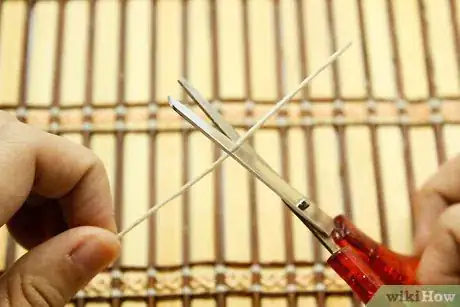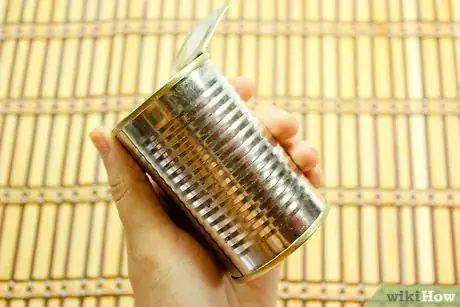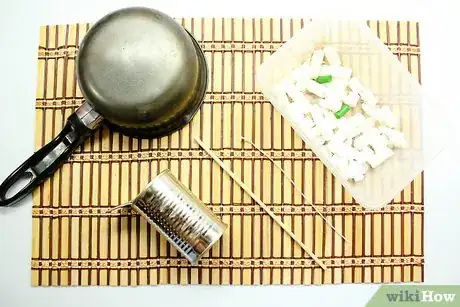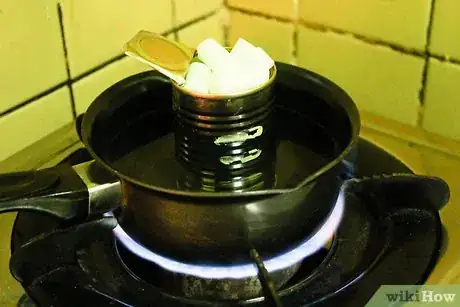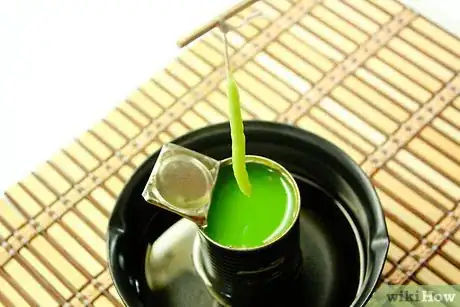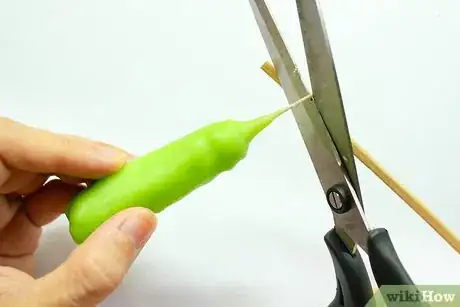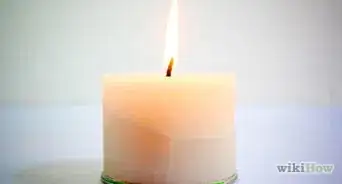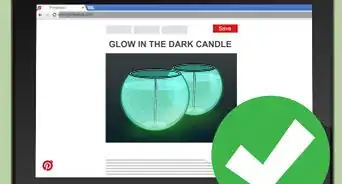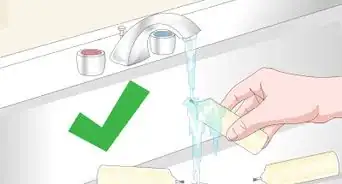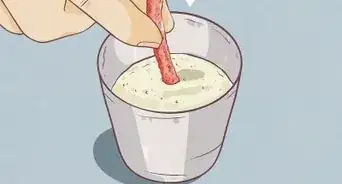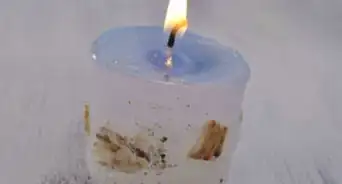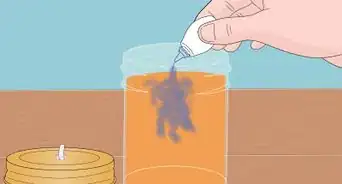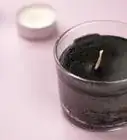X
wikiHow is a “wiki,” similar to Wikipedia, which means that many of our articles are co-written by multiple authors. To create this article, 14 people, some anonymous, worked to edit and improve it over time.
This article has been viewed 114,805 times.
Learn more...
This is an easy method for producing simple taper candles. It isn't a hard process but it is time-consuming, so make sure to have some free time. The style of taper that you produce is up to you. Shorter taper candles have a more rustic feel, while longer candles suit elegant dinner parties. The choice is yours and is created by the choice of length of taper and the amount of wax layered on.
Steps
-
1Cut the wicks to the length(s) desired. Make the wicks as long or as short as you would like. However, remember that the wick should be 4-6 inches (10-15 centimeters) longer than the candles you are making. A good wick is one that is less flexible than sewing thread, but more flexible than wire. Tie one end of the wick to a stick, such as a chopstick or a piece of dowel. This stick will be used to help you dip and to hang the candle from to dry.
-
2Ready your dipping container. The container should be long enough to cover the candle size you are making. The more elongated the container, the less wax needed and therefore less waste.Advertisement
-
3Prepare the dipping area. Dipping can take some effort, so set aside a block of time to complete it. If the wax starts to solidify, you will need to melt it again as you go, so keep an eye on this. No matter how you have chosen to melt your wax, set up the dipping place carefully:
- Put newspaper down to protect the workspace from splashes.
- Put the container of melted wax onto a trivet.
- Place this on a sturdy work space at a height suitable for you to work around.
- Ensure that the area is free of obstacles, pets and small children.
-
4Melt the wax. There are two methods for melting the wax. The first is to melt the wax in a double boiler over the saucepan. The second is to allow the wax to melt in a container of hot water set to one side. The choice of method depends on how many candles and how large the candles, along with how much wax you have to melt. If you are making a lot of candles, it will be easier to melt the candles using constant heat over a double boiler.
-
Method 1:
- Place small chunks of wax into the double boiler.
- Allow to melt. See temperature notes in "Tips".
- Keep an eye on it. Also, see "Warnings".
-
Method 2:
- Place the boiling water in a large container.
- Place the wax into the boiling water. Ensure that there is enough wax to reach the top of the container. Also make sure that the container is sitting one a safe place away from heat sources.
- Allow the wax to melt. You can stir it if needed.
-
Method 1:
-
5Commence dipping the wicks. Tighten the wick until it is straight.
- Lower the taper into the melted wax. Cover it with wax. Holding on to the top of the wick by its stick, quickly dip it into and out of the melted wax. This must be done rapidly up and down, or the wax will slip off the string. The most effective method to ensure that the wax stays on, is to set aside each candle when there is a thin layer and then to return and dip some more when you reach the last candle and proceed to dip all of the candles again.
- Gently blow on the string after each dip. This helps it to position for cooling in place.
- Note that initially the wax will coat the taper and slowly a taper candle will begin to form. Keep dipping patiently to layer on the wax.
- Reheat wax if needed.
- Repeat this process as many times as needed to form a width and shape of taper candle that you are seeking.
-
6Allow the candles to dry. Lay out the taper candles on a "drying rack". Use a small cardboard box and lay the sticks over this, with the candles dangling down. Do not let the candles touch the ground - suspend them in the air. The candles are done when they are hard to the touch.
-
7Trim the wick at both ends of the candle. At the thinner end of the finished taper, create a small wick for lighting of about 1/2" (1.2 centimeters). At the thicker end, cut the wick as close as you can to the finisher taper. Trim any wax formations that do not form part of the taper candle shape.
-
8Finished.
Advertisement
Community Q&A
-
QuestionHow can I make the candles smoother?
 Community AnswerMake sure the wax is hot. Even if it's melted, it might be too cold and start hardening too soon, resulting in the lumps and ridges. Attaching a weight to the bottom of the wick will also help to keep the candle straight. You can cut the weight off after the wick has enough wax to stay straight.
Community AnswerMake sure the wax is hot. Even if it's melted, it might be too cold and start hardening too soon, resulting in the lumps and ridges. Attaching a weight to the bottom of the wick will also help to keep the candle straight. You can cut the weight off after the wick has enough wax to stay straight. -
QuestionHow much beeswax is needed to make 50 taper candles?
 Stelios StelioskCommunity AnswerIf you have a taper candle laying around, weigh it and then multiply the grams by 50. The taper candles I make weigh 80 grams, so to make 50 I would need ~4kg of wax (80*50/1000).
Stelios StelioskCommunity AnswerIf you have a taper candle laying around, weigh it and then multiply the grams by 50. The taper candles I make weigh 80 grams, so to make 50 I would need ~4kg of wax (80*50/1000).
Advertisement
Warnings
- If you are melting the wax over the stove, do not let the wax touch the saucepan - it must remain in the top part of the double boiler or you might be subjected to toxic fumes or risk it flaming.⧼thumbs_response⧽
- Wax doesn't boil-it spontaneously burns-be sure of your flash point and stay under it!⧼thumbs_response⧽
- Be careful using the boiling water; scalding water can burn skin easily if splashed on skin.⧼thumbs_response⧽
- Do not dip over the hotplate. Remove the boiling water and perform the dipping elsewhere. If not, there is a risk of toxic fumes if the wax burns and you may even get enough momentum up for a flash fire. Just do not risk it!⧼thumbs_response⧽
Advertisement
Things You'll Need
- Boiling water
- A container that can hold boiling water for dipping the candle; the taller and slimmer, the better or you will waste a lot of wax trying to fill it up
- Wax (paraffin is a good choice) - you will need a lot - fill the dipping container almost to full with wax
- Some kind of string (for use as a wick). You can buy a spool of taper candle wick but you can also recycle existing items - see "Tips" for alternative suggestions
About This Article
Advertisement
